Marc Tyler Nobleman's Blog, page 129
May 21, 2012
"The Dark Knight Rises" and "Bill the Boy Wonder"
Batman is one of our greatest fictional champions of justice, so it is cruelly ironic that the story of where he came from hides a gross injustice: the man largely responsible for him receives no official credit.
What’s more, co-creator and original writer Bill Finger is the one who first called Batman “the Dark Knight,” yet Bill’s name will not appear in the credits of The Dark Knight Rises (nor did it in The Dark Knight). The nickname “Dark Knight” is so iconic that the word “Batman” doesn’t even need to appear with it; meanwhile, the mind behind it is left in the dark.
Yet I came up with one way to link Bill with the movie and hopefully do some good for my book in the process.
I individually e-mailed the following flyer to hundreds of independent bookstores across the country:
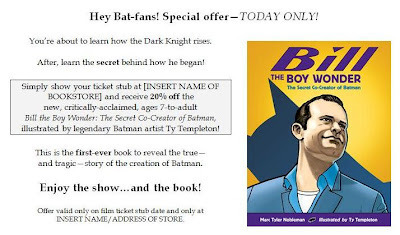 Bill the Boy Wonder: The Secret Co-Creator of Batman publishes July 1.
Bill the Boy Wonder: The Secret Co-Creator of Batman publishes July 1.
The Dark Knight Rises opens July 20.
My proposed course of action for the bookstores is simple:
Ask the nearest cinemas if they will hand out the flyer to people who buy tickets to TDKR.
That’s it.
If even the smallest fraction of moviegoers goes for the same-day incentive, I’d consider this effort a success. In part that is because the smallest fraction of the projected audience of the movie—1.939 zajillion—is several nations unto themselves.
As it stands, I couldn’t figure how to extra-sweeten the deal for the cinemas…but they have nothing to lose, either.
Perhaps they’ll view this as value-added, serving their customers some historical perspective with their blockbuster. Perhaps they’ll feel a moral obligation to do their part for Finger when so many (but not Finger) will be making so much on his genius. Perhaps they just like Batman.
Bookstores, if you set the discount, and cinemas, if we provide the flyers, who’s in?
What’s more, co-creator and original writer Bill Finger is the one who first called Batman “the Dark Knight,” yet Bill’s name will not appear in the credits of The Dark Knight Rises (nor did it in The Dark Knight). The nickname “Dark Knight” is so iconic that the word “Batman” doesn’t even need to appear with it; meanwhile, the mind behind it is left in the dark.
Yet I came up with one way to link Bill with the movie and hopefully do some good for my book in the process.
I individually e-mailed the following flyer to hundreds of independent bookstores across the country:
 Bill the Boy Wonder: The Secret Co-Creator of Batman publishes July 1.
Bill the Boy Wonder: The Secret Co-Creator of Batman publishes July 1.The Dark Knight Rises opens July 20.
My proposed course of action for the bookstores is simple:
Ask the nearest cinemas if they will hand out the flyer to people who buy tickets to TDKR.
That’s it.
If even the smallest fraction of moviegoers goes for the same-day incentive, I’d consider this effort a success. In part that is because the smallest fraction of the projected audience of the movie—1.939 zajillion—is several nations unto themselves.
As it stands, I couldn’t figure how to extra-sweeten the deal for the cinemas…but they have nothing to lose, either.
Perhaps they’ll view this as value-added, serving their customers some historical perspective with their blockbuster. Perhaps they’ll feel a moral obligation to do their part for Finger when so many (but not Finger) will be making so much on his genius. Perhaps they just like Batman.
Bookstores, if you set the discount, and cinemas, if we provide the flyers, who’s in?
Published on May 21, 2012 04:16
May 19, 2012
"In terms of sheer goofy charm, it’s hard to resist"
Newsarama kindly mentioned my trailer for Bill the Boy Wonder: The Secret Co-Creator of Batman. But since when is dressing up in purple gloves and question marks goofy?
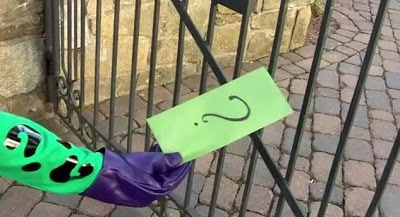


Published on May 19, 2012 04:02
May 18, 2012
Who created the creators?
On 10/28/11, Alvin Schwartz, Golden Age Superman and Batman writer and friend of Bill Finger, uncredited co-creator of Batman, passed away at 94.
Less than a year earlier, Alter Ego (#98, 12/10) ran an interview with Alvin that included some gems.
Schwartz said that Bob Kane, artist given sole official credit for Batman, flat-out “couldn’t draw.” (Others have said as much, but none with Alvin’s endearing bluntness.)
I already touched on another gem from this interview, but it bears repeating, this time with a pinch of set-up:
We’ve heard opinions like “Without Bill Finger, there wouldn’t have been any Batman” and, regrettably, “Without Bob Kane, there wouldn’t have been any Bill Finger.” But here’s a gutsy new take, courtesy of Schwartz: “Without Bill Finger, there wouldn’t have been any Bob Kane.”
I interviewed Alvin several times for my Finger book, and I could be intimidated by his deepitude. He routinely made keen observations that could turn party lines inside out.
Also in the Alter Ego interview, Schwartz said “Bill was never mean about Bob.” Sadly, the reverse was not true.
In a now-infamous 9/14/65 letter to Biljo White, editor of the fanzine Batmania, Bob vehemently tried to deny Bill’s then-recent “confession” that he, Bill, had a significant role in the creation of Batman:
“I challenge Bill to repeat those statements in front of me. … The truth is that Bill Finger is taking credit for much more than he deserves, and I refute much of his statements…”
Bob then tussles with his conscience, but keeps it deliberately fuzzy: “…in all fairness to Bill, I will admit he was influential in aiding me in shaping up the strip, and there are certain characters Bill created, aside from my main characters and many other characters that I created, including the Batmobile. It’s been 25 years now, and truthfully, time sometimes blurs the memory and it is difficult to separate, at times, the myth from the truth, so that I cannot blame Bill too much if at times his memory ‘clouds.’”
But you should have blamed yourself.
Then Bob goes back for another potshot: “Your article [about Bill’s contribution to Batman] is completely misleading, loaded with untruths fed to you by Finger’s hallucinations of grandeur.”
Finally, when asked who came up with the initial idea for Batman, Schwartz takes a stance more radical than most: “I can tell you this: it was Bill. Bob never had any ideas. He really was a man with very little taste…”
Years after Bill died in 1974, his old friend Alvin (like Jerry Robinson) evolved into one of Bill’s most fervent public advocates. Alvin was especially important because he could speak out on Bill’s behalf from personal experience.
Maybe now Bill has been able to thank Alvin for that.
Less than a year earlier, Alter Ego (#98, 12/10) ran an interview with Alvin that included some gems.
Schwartz said that Bob Kane, artist given sole official credit for Batman, flat-out “couldn’t draw.” (Others have said as much, but none with Alvin’s endearing bluntness.)
I already touched on another gem from this interview, but it bears repeating, this time with a pinch of set-up:
We’ve heard opinions like “Without Bill Finger, there wouldn’t have been any Batman” and, regrettably, “Without Bob Kane, there wouldn’t have been any Bill Finger.” But here’s a gutsy new take, courtesy of Schwartz: “Without Bill Finger, there wouldn’t have been any Bob Kane.”
I interviewed Alvin several times for my Finger book, and I could be intimidated by his deepitude. He routinely made keen observations that could turn party lines inside out.
Also in the Alter Ego interview, Schwartz said “Bill was never mean about Bob.” Sadly, the reverse was not true.
In a now-infamous 9/14/65 letter to Biljo White, editor of the fanzine Batmania, Bob vehemently tried to deny Bill’s then-recent “confession” that he, Bill, had a significant role in the creation of Batman:
“I challenge Bill to repeat those statements in front of me. … The truth is that Bill Finger is taking credit for much more than he deserves, and I refute much of his statements…”
Bob then tussles with his conscience, but keeps it deliberately fuzzy: “…in all fairness to Bill, I will admit he was influential in aiding me in shaping up the strip, and there are certain characters Bill created, aside from my main characters and many other characters that I created, including the Batmobile. It’s been 25 years now, and truthfully, time sometimes blurs the memory and it is difficult to separate, at times, the myth from the truth, so that I cannot blame Bill too much if at times his memory ‘clouds.’”
But you should have blamed yourself.
Then Bob goes back for another potshot: “Your article [about Bill’s contribution to Batman] is completely misleading, loaded with untruths fed to you by Finger’s hallucinations of grandeur.”
Finally, when asked who came up with the initial idea for Batman, Schwartz takes a stance more radical than most: “I can tell you this: it was Bill. Bob never had any ideas. He really was a man with very little taste…”
Years after Bill died in 1974, his old friend Alvin (like Jerry Robinson) evolved into one of Bill’s most fervent public advocates. Alvin was especially important because he could speak out on Bill’s behalf from personal experience.
Maybe now Bill has been able to thank Alvin for that.
Published on May 18, 2012 04:22
May 17, 2012
Peter David tweets about "Bill the Boy Wonder"
On 5/1/12, fan-favorite comic book writer Peter David (whom I don't know personally) kindly tweeted several times about Bill the Boy Wonder: The Secret Co-Creator of Batman:
 Thank you Peter.
Thank you Peter.
Published on May 17, 2012 04:47
May 16, 2012
Low-grade curiosity
In researching Bill the Boy Wonder: The Secret Co-Creator of Batman, I spoke with hundreds of people, several dozen of whom I “formally” interviewed. I was surprised at how few asked me how I found them, especially because many of them were not simply a Google away and are probably aware of that. I don’t know if they just didn’t think to ask me, or if they simply didn’t care—but it’d be one of the first questions I'd ask if someone came ‘round to question me (and I didn’t have a blog making the answer obvious).
Perhaps these people were not under-curious. Perhaps I’m just over-curious, preoccupied with sublevels of information that others don’t bother with because they understand that there’s no practical use for that information.
Another example: my massive blog series featuring interviews with and previously unpublished photos of 100 “lost” superhero stars of the ‘70s and ‘80s required lots of hunting…sometimes so deep I couldn’t see two feet behind me.
Yet the kind folks who ultimately helped me reach particularly obscured performers including Garrett Craig, Larry Marks, and Austin Roberts did not ask me how I knew to ask them. And look at how common those three names are—they are all over the Internet. Plus the people I was asking did not always share the same last name as my quarry. (In other words, I presumed that the people I was asking would realize that I would have had to do more than casual research to make that connection.)
I’m not judging. I’m just different. It’s an occupational perk.
Perhaps these people were not under-curious. Perhaps I’m just over-curious, preoccupied with sublevels of information that others don’t bother with because they understand that there’s no practical use for that information.
Another example: my massive blog series featuring interviews with and previously unpublished photos of 100 “lost” superhero stars of the ‘70s and ‘80s required lots of hunting…sometimes so deep I couldn’t see two feet behind me.
Yet the kind folks who ultimately helped me reach particularly obscured performers including Garrett Craig, Larry Marks, and Austin Roberts did not ask me how I knew to ask them. And look at how common those three names are—they are all over the Internet. Plus the people I was asking did not always share the same last name as my quarry. (In other words, I presumed that the people I was asking would realize that I would have had to do more than casual research to make that connection.)
I’m not judging. I’m just different. It’s an occupational perk.
Published on May 16, 2012 04:01
May 15, 2012
Behind the “Bill the Boy Wonder” book trailer
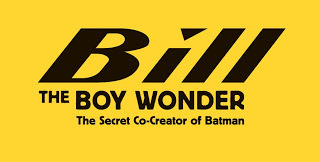
Without my longtime friend Christian, my book trailer for Bill the Boy Wonder: The Secret Co-Creator of Batman would have looked like the one for Boys of Steel: The Creators of Superman.
In other words, there wouldn’t be one.
This trailer is not the first big project Christian and I have undertaken together. We go back to a Styrofoam-ball solar system in fourth grade. Maybe you haven’t heard of it.
The trailer contains a few bloopers we know of and likely more we don’t. As for the former:
Riddler’s costume does not have enough question marks. (I imagined we’d see only the forearm in his shot but we end up seeing some of his shoulder, too.)Did you spot the stray Whole Foods paper bag?
Not a blooper, but the man-on-the-street interviews contain a bit too much product placement. (Yet no payola.)
I wanted the Riddler scene to take place at night but it would have looked too dark without proper lighting (which we didn’t have).
We wanted to use an 8½ x 11 green envelope for Riddler’s note; that would’ve allowed Robin to remove the note without having to unfold it. However, I couldn’t find such an envelope in time.
In the “Robin approaching” shot, I was worried that the reflective Nike logo on the black running pants I was wearing would be visible. It was not.
In the Batcave computer room shot, I was worried that the cursor on the computer screens would be visible. It was not.
We didn’t shoot consecutively so I attempted to keep my stubble consistent. I think I failed, however.
The two buttons (Batman logo and MTN) were color printouts taped over Staples Easy buttons.
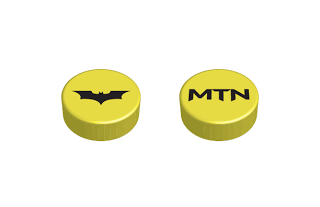

The paper didn’t adhere evenly to the buttons, so if the lighting were any better in that scene, the whole thing would’ve looked even cheesier.
It was hard to make out, but the ringing cell phone said “Batman.” If we had zoomed in any closer, it would’ve been too blurry.
It was daytime when we shot me looking out the window at the MTN-Signal, which is in the night sky. Clumsy filmmaking or subtle joke?
The quality of the Bill Finger voiceover is as good as we could get; it came from a reel-to-reel tape from 1972. It’s the first time the public has heard Bill’s voice.
I discovered the song “Try” in 1994 when it appeared in the “World Happiness Dance” scene of an episode of My So-Called Life. In the pre-Internet age, I had to buy a guy at ABC dinner for getting back to me with the name of the song (which, as I recall, wasn’t identified in the credits).
The man-on-street, Marc-on-the-street, Wayne Manor gate, “Batman calling,” and “calling Batman” scenes were shot in Maryland.
The Batcave and walking-to-car scenes were shot in Virginia.
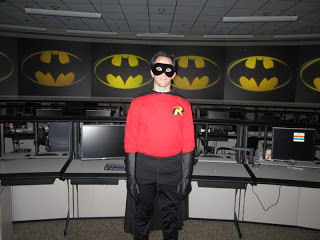
Here’s where we went to dinner after the third (of three) shoots:
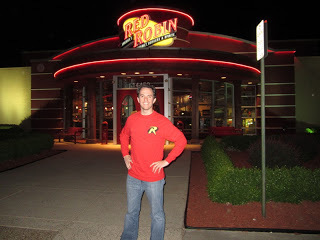 Yes, I was still wearing my Robin shirt. No, this was not planned.
Yes, I was still wearing my Robin shirt. No, this was not planned.Budget:
$144.30 supplies (primarily the costumes and the Staples Easy buttons)
$56.93 craft services (i.e. a couple of dinners for my crew, AKA Christian)
$201.23 total
Time put in (not counting undocumented prep time, drive time):
4 hours shooting 2/25/12
1 hour shooting 4/10/12
2 hours shooting 4/18/12
6 hours editing 4/22/12
1 hour editing post-4/22/12
14 hours total
I chose Riddler for the villain for several reasons:
It lent itself the best to the set-up—namely, posing to Batman (and by extension the viewer) the question/riddle “Who created you (Batman)?”The Riddler costume is easily recognizable when only a fragment of it is shown.The Riddler was created by Bill Finger.
Published on May 15, 2012 04:00
May 14, 2012
First time presenting at the International Reading Association Convention
Last summer, I submitted two proposals for the 2012 IRA Convention. One was a lively panel of authors of picture book nonfiction called “But Kids Haven’t Heard of That: Why Teaching Unconventional Nonfiction Is Important.” The other was a variation on a popular workshop I give nationwide. It’s normally “The Language of Cartoons”; I renamed this version “Teaching with Humor.”
I’d heard that it’s tough to craft a proposal due to exacting IRA criteria, and I’d heard that the audiences can have high expectations (as they should). For those reasons and more, I was doubly thrilled not only for one of my proposals to be chosen but for the session to be, in my estimation, a whopping success. Incidentally, I guessed wrong on which proposal stood a better chance of getting a yes.
On 5/2/12 in Chicago, I presented “Teaching with Humor.” (Try you again this year, “But Kids Haven’t Heard of It”!).
The room was big—it held at least 200—and I’m happy to report that it was standing room only. People continued to trickle in for a while after I started; eventually some had no choice but to sit on the floor (violation!)—and I even had a few who had no choice but to occupy the seats behind me (at the pushed-back “panel table” that had been alongside my podium). They could still see the screen but when I began drawing examples, they had to relocate and find space in front of the table.
I’m told that it is especially difficult to get a good turnout on the last day, which this was, and I was even more grateful considering my slot was perilously close to lunch.
Here is selected feedback:
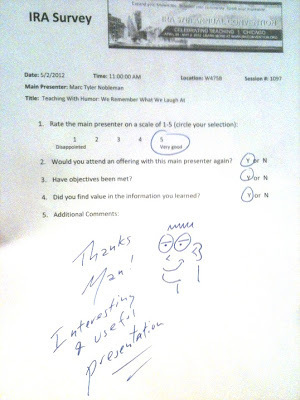
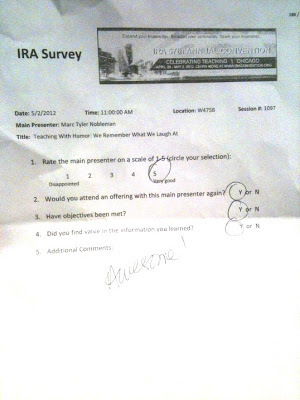
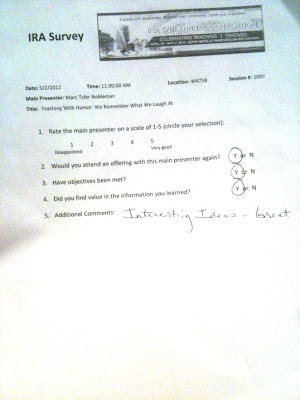
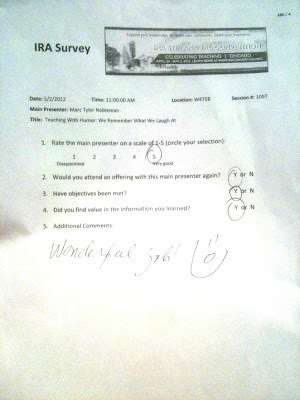
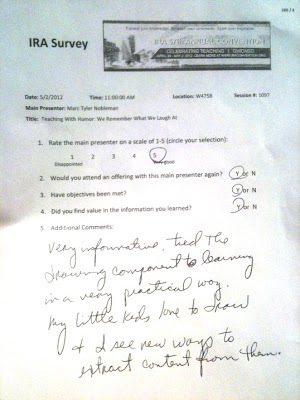
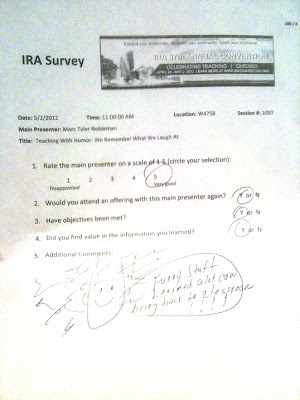
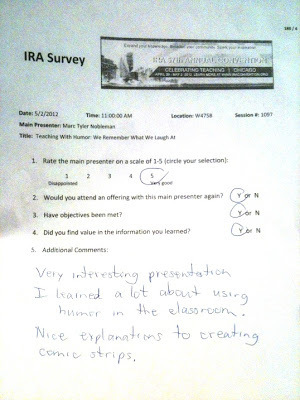
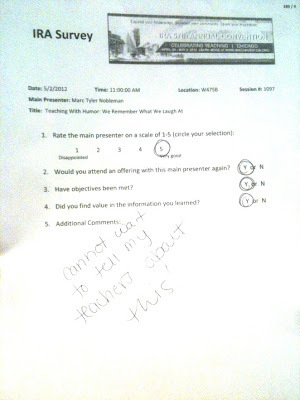 Thank you, IRA, for the opportunity, thank you, attendees, for attending, and thank you again, Scholastic, for sponsoring me.
Thank you, IRA, for the opportunity, thank you, attendees, for attending, and thank you again, Scholastic, for sponsoring me.
I’d heard that it’s tough to craft a proposal due to exacting IRA criteria, and I’d heard that the audiences can have high expectations (as they should). For those reasons and more, I was doubly thrilled not only for one of my proposals to be chosen but for the session to be, in my estimation, a whopping success. Incidentally, I guessed wrong on which proposal stood a better chance of getting a yes.
On 5/2/12 in Chicago, I presented “Teaching with Humor.” (Try you again this year, “But Kids Haven’t Heard of It”!).
The room was big—it held at least 200—and I’m happy to report that it was standing room only. People continued to trickle in for a while after I started; eventually some had no choice but to sit on the floor (violation!)—and I even had a few who had no choice but to occupy the seats behind me (at the pushed-back “panel table” that had been alongside my podium). They could still see the screen but when I began drawing examples, they had to relocate and find space in front of the table.
I’m told that it is especially difficult to get a good turnout on the last day, which this was, and I was even more grateful considering my slot was perilously close to lunch.
Here is selected feedback:







 Thank you, IRA, for the opportunity, thank you, attendees, for attending, and thank you again, Scholastic, for sponsoring me.
Thank you, IRA, for the opportunity, thank you, attendees, for attending, and thank you again, Scholastic, for sponsoring me.
Published on May 14, 2012 04:00
May 13, 2012
Laurel Ridge Elementary, Fairfax, VA
On 5/11/12, I spoke at Laurel Ridge Elementary in Fairfax, VA. More than a week prior, the school displayed this in the library:
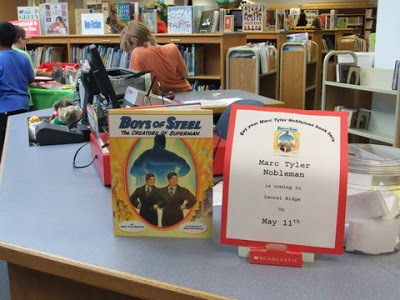 It was a great school, and patient. I had a raspy voice after several days in bed and the kids did not exploit my weakness.
It was a great school, and patient. I had a raspy voice after several days in bed and the kids did not exploit my weakness.
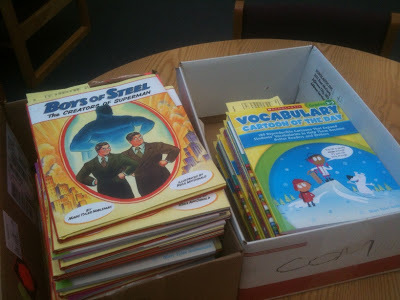

 It was a great school, and patient. I had a raspy voice after several days in bed and the kids did not exploit my weakness.
It was a great school, and patient. I had a raspy voice after several days in bed and the kids did not exploit my weakness. 
Published on May 13, 2012 04:40
May 12, 2012
"10 Things Westfield Comics Likes About July 2012 Comics"
At the Westfield Comics blog, KC Carlson put Bill the Boy Wonder: The Secret Co-Creator of Batman on his list.
He says that "every comics fan should enjoy this fond look at one of comic books' great 'lost' creators."
(He also says that the book is "primarily...intended for younger readers and children’s libraries"; all true except the "primarily." I call it an all-ages picture book.)
Thank you Westfield Comics and KC Carlson.
He says that "every comics fan should enjoy this fond look at one of comic books' great 'lost' creators."
(He also says that the book is "primarily...intended for younger readers and children’s libraries"; all true except the "primarily." I call it an all-ages picture book.)
Thank you Westfield Comics and KC Carlson.
Published on May 12, 2012 04:00
May 11, 2012
Bill Finger: The DC Comics tributes
When Bill Finger, uncredited co-creator of Batman, died in 1974, it went unrecognized in the mainstream media. But the same year, DC Comics ran two memorials in lesser-seen publications; the first the only obituary Bill got. I’ve shown them before and here they are again:
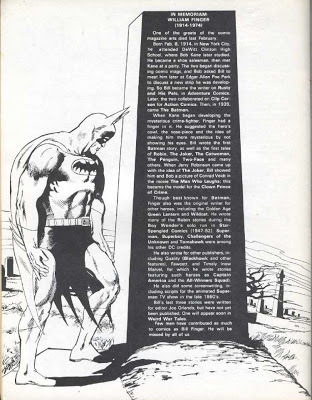 Amazing World of DC Comics #1 (July-August 1974)
Amazing World of DC Comics #1 (July-August 1974)
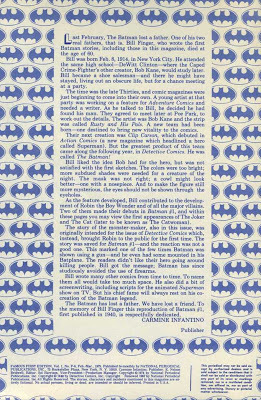 Famous 1st Edition (Batman #1) # F-5 (February-March 1975)
Famous 1st Edition (Batman #1) # F-5 (February-March 1975)
Here’s a third, from Batman in the Seventies:
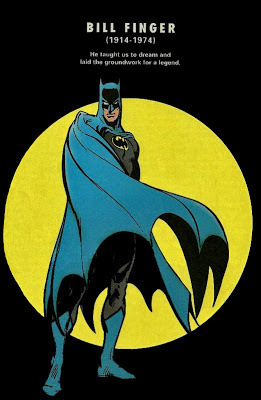 And thanks to 20th Century Danny Boy, I learned of the following:
And thanks to 20th Century Danny Boy, I learned of the following:
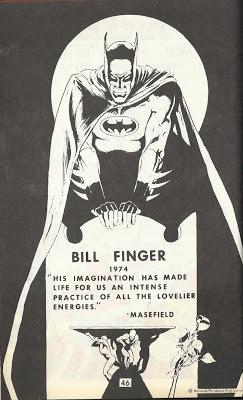 It’s not from a DC publication but rather from the program of the 1974 New York Comicon. (Bill died in January 1974.)
It’s not from a DC publication but rather from the program of the 1974 New York Comicon. (Bill died in January 1974.)
My “obituary” for Bill Finger is out in July, and it’s a long-overdue tribute to a man whose cultural impact is, without hyperbole, astronomical.
 Amazing World of DC Comics #1 (July-August 1974)
Amazing World of DC Comics #1 (July-August 1974) Famous 1st Edition (Batman #1) # F-5 (February-March 1975)
Famous 1st Edition (Batman #1) # F-5 (February-March 1975)Here’s a third, from Batman in the Seventies:
 And thanks to 20th Century Danny Boy, I learned of the following:
And thanks to 20th Century Danny Boy, I learned of the following: It’s not from a DC publication but rather from the program of the 1974 New York Comicon. (Bill died in January 1974.)
It’s not from a DC publication but rather from the program of the 1974 New York Comicon. (Bill died in January 1974.)My “obituary” for Bill Finger is out in July, and it’s a long-overdue tribute to a man whose cultural impact is, without hyperbole, astronomical.
Published on May 11, 2012 04:37



